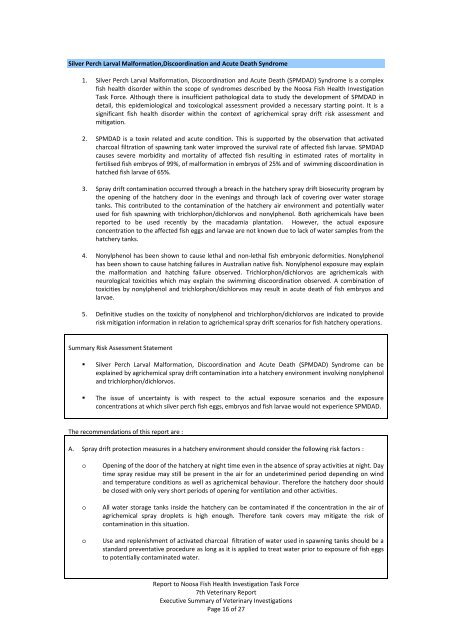37 7th Veterinary Report - Department of Primary Industries ...
37 7th Veterinary Report - Department of Primary Industries ...
37 7th Veterinary Report - Department of Primary Industries ...
You also want an ePaper? Increase the reach of your titles
YUMPU automatically turns print PDFs into web optimized ePapers that Google loves.
Silver Perch Larval Malformation,Discoordination and Acute Death Syndrome<br />
1. Silver Perch Larval Malformation, Discoordination and Acute Death (SPMDAD) Syndrome is a complex<br />
fish health disorder within the scope <strong>of</strong> syndromes described by the Noosa Fish Health Investigation<br />
Task Force. Although there is insufficient pathological data to study the development <strong>of</strong> SPMDAD in<br />
detail, this epidemiological and toxicological assessment provided a necessary starting point. It is a<br />
significant fish health disorder within the context <strong>of</strong> agrichemical spray drift risk assessment and<br />
mitigation.<br />
2. SPMDAD is a toxin related and acute condition. This is supported by the observation that activated<br />
charcoal filtration <strong>of</strong> spawning tank water improved the survival rate <strong>of</strong> affected fish larvae. SPMDAD<br />
causes severe morbidity and mortality <strong>of</strong> affected fish resulting in estimated rates <strong>of</strong> mortality in<br />
fertilised fish embryos <strong>of</strong> 99%, <strong>of</strong> malformation in embryos <strong>of</strong> 25% and <strong>of</strong> swimming discoordination in<br />
hatched fish larvae <strong>of</strong> 65%.<br />
3. Spray drift contamination occurred through a breach in the hatchery spray drift biosecurity program by<br />
the opening <strong>of</strong> the hatchery door in the evenings and through lack <strong>of</strong> covering over water storage<br />
tanks. This contributed to the contamination <strong>of</strong> the hatchery air environment and potentially water<br />
used for fish spawning with trichlorphon/dichlorvos and nonylphenol. Both agrichemicals have been<br />
reported to be used recently by the macadamia plantation. However, the actual exposure<br />
concentration to the affected fish eggs and larvae are not known due to lack <strong>of</strong> water samples from the<br />
hatchery tanks.<br />
4. Nonylphenol has been shown to cause lethal and non‐lethal fish embryonic deformities. Nonylphenol<br />
has been shown to cause hatching failures in Australian native fish. Nonylphenol exposure may explain<br />
the malformation and hatching failure observed. Trichlorphon/dichlorvos are agrichemicals with<br />
neurological toxicities which may explain the swimming discoordination observed. A combination <strong>of</strong><br />
toxicities by nonylphenol and trichlorphon/dichlorvos may result in acute death <strong>of</strong> fish embryos and<br />
larvae.<br />
5. Definitive studies on the toxicity <strong>of</strong> nonylphenol and trichlorphon/dichlorvos are indicated to provide<br />
risk mitigation information in relation to agrichemical spray drift scenarios for fish hatchery operations.<br />
Summary Risk Assessment Statement<br />
Silver Perch Larval Malformation, Discoordination and Acute Death (SPMDAD) Syndrome can be<br />
explained by agrichemical spray drift contamination into a hatchery environment involving nonylphenol<br />
and trichlorphon/dichlorvos.<br />
The issue <strong>of</strong> uncertainty is with respect to the actual exposure scenarios and the exposure<br />
concentrations at which silver perch fish eggs, embryos and fish larvae would not experience SPMDAD.<br />
The recommendations <strong>of</strong> this report are :<br />
A. Spray drift protection measures in a hatchery environment should consider the following risk factors :<br />
o Opening <strong>of</strong> the door <strong>of</strong> the hatchery at night time even in the absence <strong>of</strong> spray activities at night. Day<br />
time spray residue may still be present in the air for an undeterimined period depending on wind<br />
and temperature conditions as well as agrichemical behaviour. Therefore the hatchery door should<br />
be closed with only very short periods <strong>of</strong> opening for ventilation and other activities.<br />
o All water storage tanks inside the hatchery can be contaminated if the concentration in the air <strong>of</strong><br />
agrichemical spray droplets is high enough. Therefore tank covers may mitigate the risk <strong>of</strong><br />
contamination in this situation.<br />
o Use and replenishment <strong>of</strong> activated charcoal filtration <strong>of</strong> water used in spawning tanks should be a<br />
standard preventative procedure as long as it is applied to treat water prior to exposure <strong>of</strong> fish eggs<br />
to potentially contaminated water.<br />
<strong>Report</strong> to Noosa Fish Health Investigation Task Force<br />
<strong>7th</strong> <strong>Veterinary</strong> <strong>Report</strong><br />
Executive Summary <strong>of</strong> <strong>Veterinary</strong> Investigations<br />
Page 16 <strong>of</strong> 27

















